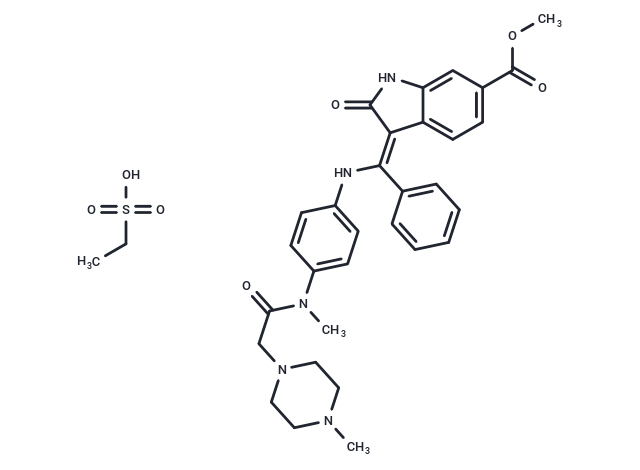Shopping Cart
- Remove All
 Your shopping cart is currently empty
Your shopping cart is currently empty

Nintedanib esylate (BIBF 1120 esylate) is a potent triple angiokinase inhibitor targeting VEGFR1/2/3, FGFR1/2/3, and PDGFRα/β.

| Pack Size | Price | Availability | Quantity |
|---|---|---|---|
| 5 mg | $36 | In Stock | |
| 10 mg | $52 | In Stock | |
| 25 mg | $65 | In Stock | |
| 50 mg | $77 | In Stock | |
| 100 mg | $107 | In Stock | |
| 200 mg | $167 | In Stock | |
| 500 mg | $333 | In Stock | |
| 1 mL x 10 mM (in DMSO) | $57 | In Stock |
| Description | Nintedanib esylate (BIBF 1120 esylate) is a potent triple angiokinase inhibitor targeting VEGFR1/2/3, FGFR1/2/3, and PDGFRα/β. |
| Targets&IC50 | PDGFRβ:65 nM, PDGFRα:59 nM, FGFR3:108 nM, FGFR1:69 nM, FGFR2:37 nM, VEGFR1:34 nM, VEGFR3:13 nM, VEGFR2:13 nM |
| In vitro | BIBF 1120 binds to the ATP-binding site in the cleft between the amino and carboxy terminal lobes of the kinase domain. BIBF 1120 inhibits proliferation of PDGF-BB stimulated BRPs with EC50 of 79 nM in cell assays. BIBF1120 (100 nM) blocks activation of MAPK after stimulation with 5% serum plus PDGF-BB. BIBF1120 prevents PDGF-BB stimulated proliferation with an EC50 of 69 nM in cultures of human vascular smooth muscle cells (HUASMC). |
| In vivo | BIBF1120, administered orally at doses ranging from 25-100 mg/kg daily, demonstrates high efficacy across various tumor models, including human tumor xenografts in nude mice and a syngeneic rat tumor model. Its effectiveness is confirmed through magnetic resonance imaging, which shows significant reductions in tumor perfusion, vessel density, and vessel integrity within 3 to 5 days, leading to substantial growth inhibition. Moreover, BIBF1120 is well-tolerated and exhibits promising results in in vivo tumor models, highlighting its potential as an effective oral therapeutic option. |
| Kinase Assay | Enzyme activity is assayed in the presence or absence of serial dilutions of BIBF1120 performed in 25% DMSO. Each microtiter plate contains internal controls such as blank, maximum reaction, and historical reference compound. All incubations are conducted at room temperature on a rotation shaker. 10 μL of each BIBF1120 dilution is added to 10 μL of diluted kinase (0.8 μg/mL VEGFR2, 10 mM Tris pH 7.5, 2 mM EDTA, and 2 mg/mL BSA) and preincubated for 1 hour. The reaction is started by addition of 30 μL of substrate mix containing 62.4 mM Tris pH 7.5, 2.7 mM DTT, 5.3 mM MnCl2, 13.3 mM Mg-acetate, 0.42 mM ATP, 0.83 mg/mL Poly-Glu-Tyr(4:1), and 1.7 μg/mL Poly-Glu-Tyr(4:1)-biotin and incubated for 1 hour. The reaction is stopped by addition of 50 μL of 250 mM EDTA, 20 mM HEPES, pH 7.4. 90 μL of the reaction mix is transferred to a streptavidin plate and incubated for 1-2 hours. After three washes with PBS the EU-labeled antibody, PY20 is added (recommended dilution 1:2000 of 0.5 mg/mL labeled antibody in DELFIA assay buffer). Excessive detection antibody is removed by three ishes of DELFIA washing buffer. Then 10 minutes before measurement on the multilabel reader, each well is incubated with 100 μL of DELFIA enhancement solution. |
| Animal Research | Five-week-old to 6-wk-old athymic NMRI-nu/nu female mice (21-31 g) are used for the assay. After acclimatization, mice are inoculated with 1 to 5×106 (in 100 μL) FaDu, Caki-1, SKOV-3, H460, HT-29, or PAC-120 cells s.c. into the right flank of the animal. After acclimatization, F344 Fischer rats are injected with 5×106 (in 100 μL) GS-9L cells s.c. into the right flank of the animal. For pharmacokinetic analysis, blood is isolated at indicated time points from the retroorbital plexus of mice and plasma is analyzed using high performance liquid chromatography-mass spectrometry methodology. |
| Alias | Nintedanib Ethanesulfonate Salt, BIBF 1120 (esylate) |
| Molecular Weight | 649.76 |
| Formula | C31H33N5O4.C2H6O3S |
| Cas No. | 656247-18-6 |
| Smiles | CCS(O)(=O)=O.COC(=O)c1ccc2c(NC(=O)\C2=C(/Nc2ccc(cc2)N(C)C(=O)CN2CCN(C)CC2)c2ccccc2)c1 |
| Relative Density. | no data available |
| Storage | keep away from direct sunlight | Powder: -20°C for 3 years | In solvent: -80°C for 1 year | Shipping with blue ice. | ||||||||||||||||||||||||||||||
| Solubility Information | DMSO: 45 mg/mL (69.26 mM), Sonication and heating are recommended. | ||||||||||||||||||||||||||||||
Solution Preparation Table | |||||||||||||||||||||||||||||||
DMSO
| |||||||||||||||||||||||||||||||

Copyright © 2015-2025 TargetMol Chemicals Inc. All Rights Reserved.